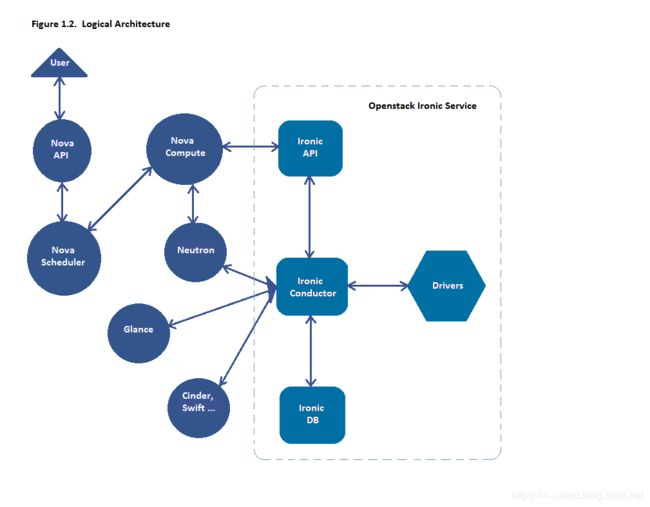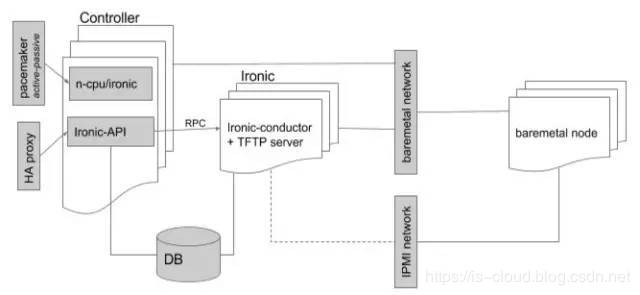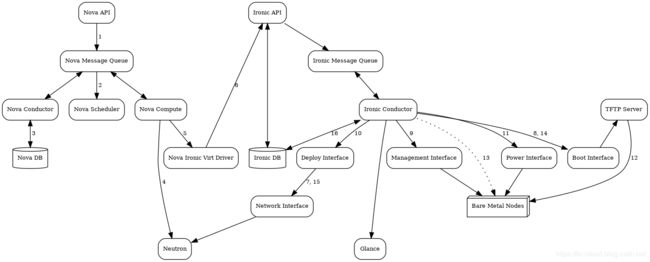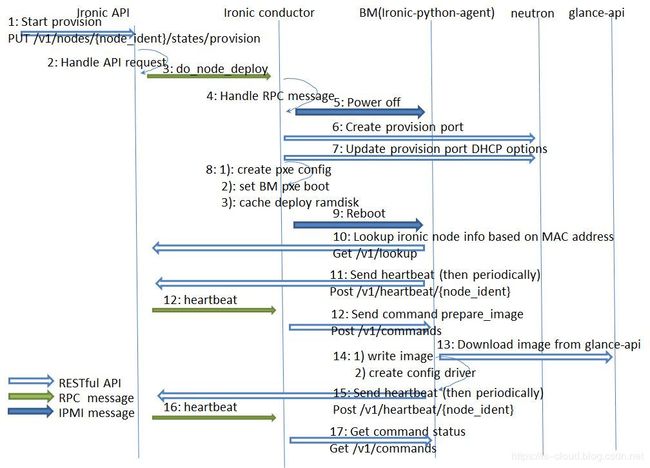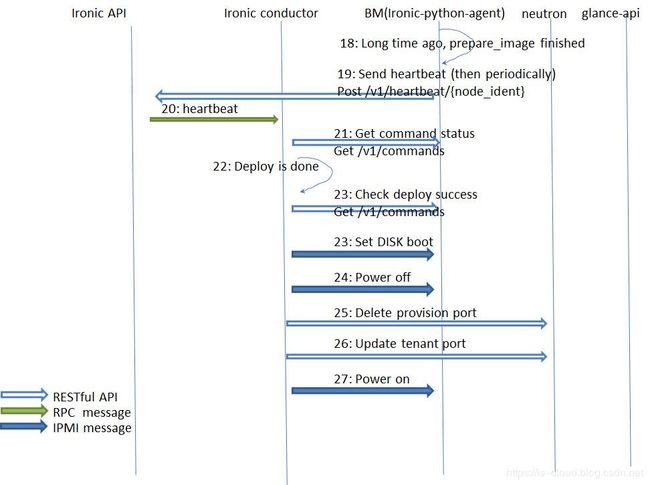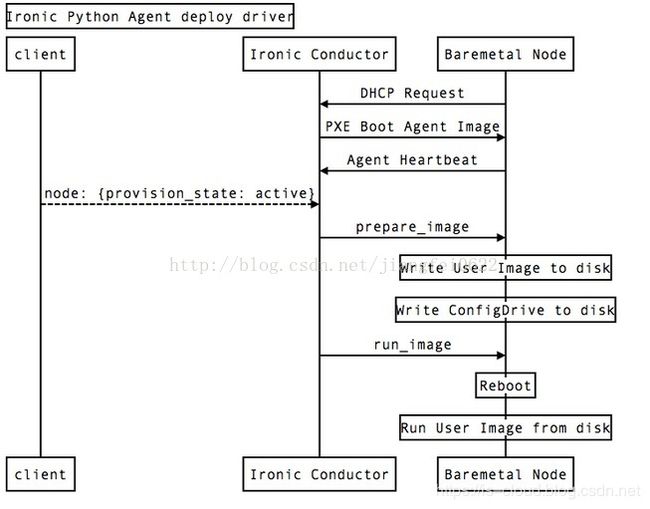- 【2023年】云计算金砖牛刀小试6
geekgold
云计算服务器网络kubernetes容器
第一套【任务1】私有云服务搭建[10分]【题目1】基础环境配置[0.5分]使用提供的用户名密码,登录提供的OpenStack私有云平台,在当前租户下,使用CentOS7.9镜像,创建两台云主机,云主机类型使用4vCPU/12G/100G_50G类型。当前租户下默认存在一张网卡,自行创建第二张网卡并连接至controller和compute节点(第二张网卡的网段为10.10.X.0/24,X为工位号
- KVM虚拟化平台
大西瓜不爱告诉你姓名
虚拟化KVM虚拟化
前言1、云计算的定义云计算的定义用户可以在任何时间、地点通过网络获取所需要的计算资源、网络资源、存储资源并且按量计费、弹性伸缩云计算就是一个大的租赁渠首云计算这个大的资源池中的各种资源(以租赁的形式)云计算所汇聚的这部分资源(通过云平台的方式汇聚这些资源)而云平台比如:阿里云、华为云这些云平台使用到的底层平台技术为OpenStack而OpenStack利用了什么技术将资源可以划分给不同的用户使用呢
- 【2023年】云计算金砖牛刀小试3
geekgold
云计算linux运维容器kubernetes云原生
A场次题目:OpenStack平台部署与运维业务场景:某企业拟使用OpenStack搭建一个企业云平台,用于部署各类企业应用对外对内服务。云平台可实现IT资源池化,弹性分配,集中管理,性能优化以及统一安全认证等。系统结构如下图:企业云平台的搭建使用竞赛平台提供的两台云服务器,配置如下表:设备名称主机名接口ip地址云服务器1controllereth0,eth1私网:192.168.100.10/2
- 【2023年】云计算金砖牛刀小试
geekgold
linux容器grafanaprometheusansiblekubernetes云原生
A模块题目OpenStack平台部署与运维任务1私有云平台环境初始化(6分)IP主机名192.168.157.30controller192.168.157.31compute1.配置主机名把controller节点主机名设置为controller,compute节点主机名设置为compute。分别在controller节点和compute节点将hostname命令的返回结果提交到答题框。【0.5
- 【2023年】云计算金砖牛刀小试2
geekgold
云计算运维容器jenkinskubernetesdevopsdocker
A场次题目:Openstack平台部署与运维control172.17.31.10compute172.17.31.20compute任务1私有云平台环境初始化1.初始化操作系统使用提供的用户名密码,登录竞赛云平台。根据表1中的IP地址规划,设置各服务器节点的IP地址,确保网络正常通信,设置控制节点主机名为Controller,计算节点主机名为Compute,并修改hosts文件将IP地址映射为主
- CentOS 安装 Openstack --按 rdo 方式
weixin_44251398
centosopenstack
安装方式:OpenStack是一个开源的云计算管理平台项目,能支持几乎所有类型的云环境。OpenStack提供了基础设施即服务(IaaS)的解决方案,每个服务都可提供API以进行集成。OpenStack覆盖了网络、虚拟化、操作系统、服务器等各个方面。openstack安装方法有很多种,主流有四种方式,包括(1)手动一步一步安装,(2)fuel安装,(3)devstack安装和(4)rdo安装,RD
- OpenStack Ironic 裸金属的配置及使用
Ankele
云计算ironic裸金属物理机openstack配置
环境当前OpenStack版本为Rocky操作系统为CentOS7.6api节点即控制节点conductor节点即裸金属计算节点控制节点node1、node2、node3计算节点node1、node2、node3、node4裸金属服务节点node4虚拟IPvip一、安装软件包在所有节点上都安装yum仓库yuminstallcentos-release-openstack-rocky-y在api节点
- openstack运维命令整理
sky wide
openstacklinux
openstack运维命令文章原始同步:微信搜索公众号:skywide技术QQ技术群:308191819欢迎各位加入Keystone相关命令用户相关命令创建用户:keystoneuser-create--name=xxx--pass=xxx--tenant=xxx删除用户:keystoneuser-deletexxx更新用户:keystoneuser-update--name=xxx--enabl
- OpenStack添加新硬盘到LVM逻辑卷组
LianZhenLiang
参考:CinderLVM配置https://www.cnblogs.com/sammyliu/p/4159147.htmlConfigureandusevolumenumberweigherhttps://docs.openstack.org/cinder/queens/admin/blockstorage-volume-number-weigher.html一、知识:cinderlvm配置(/e
- mirantis OpenStack9.0在virtualbox上的部署
Caroline_33
openstackmirantisvirtualbox
实验环境安装包-VirtualBox-4.3.12-93733-Win.exe-Oracle_VM_VirtualBox_Extension_Pack-5.1.2-108956.vbox-extpack-Mirantis_Openstack9.0.iso-bootstrap.zip-mirrors.zip-xtfp-xshell实验机器-cpu:i3-3220以上-Ram:至少8G说明-保证内存至
- 云计算day32
巭氼
云计算
docker容器==》k8s编排=〉openstack存储监控⽇志以及其他的内容回顾1.环境的安装catoverlay>br_netfilter>EOFoverllaybr_netfiltercatnet.bridge.bridge-nf-call-iptables=1>net.bridge.bridge-nf-call-ip6tables=1>net.ipv4.ip_forward=1>EOF#
- Openstack 与 Ceph集群搭建(下): Openstack部署
范枝洲
系统运维openstackceph
文章目录文章参考部署节点准备1.修改Host文件与hostname名称2.安装NTP软件3.网卡配置信息4.开启Docker共享挂载5.安装python虚拟环境6.安装kolla-ansible7.加载AnsiblegalaxyrequirementsOpenstack安装前预配置1.配置密码2.配置multinode文件3.修改全局配置文件Openstack正式安装1.启动bootstrap-s
- OpenStack云计算平台实战
港南四大炮亡
openstack云计算
项目一任务一了解云计算目前主流的开源云计算平台如下:OpenStack。OpenStack是一个提供IAAS开源解决方案的全球性项目,由Rackspace公司和NASA共同创办,采用了Apache2.0许可证,可以随意使用。OpenStack并不要求使用专门的硬件和软件,可以在虚拟系统或裸机系统中运行。它支持多种虚拟机管理器(KVM和XenServer)和容器技术。OpenStack适应不同的用户
- 2022年河南省高等职业教育技能大赛云计算赛项竞赛赛卷(样卷)
忘川_ydy
云计算云计算openstackkubernetesdockerpythonk8sansible
#需要资源(软件包及镜像)或有问题的,可私博主!!!#需要资源(软件包及镜像)或有问题的,可私博主!!!#需要资源(软件包及镜像)或有问题的,可私博主!!!第一部分:私有云任务1私有云服务搭建(10分)使用提供的用户名密码,登录竞赛用的云计算平台,按要求自行使用镜像创建两台云主机,创建完云主机后确保网络正常通信,然后按要求配置服务器。根据提供安装脚本框架,补充脚本完成OpenStack平台的安装搭
- OpenStack计算节点Neutron计算节点的安装与部署
PPLIA579
openstack
1.1实验目的(1)学习掌握Linux网桥代理,配置计算服务以使用网络服务,安装计算节点1.2实验要求(1)实验分组人数要求1人;(2)实验仪器设备或实验环境要求:8G内存、100G硬盘电脑或华为云平台对应配置ECS弹性云服务器;(3)按照实验文档内容操作,在操作成功后截图,保存实验文档;(4)实验完成后创建镜像。1.3实验预备知识(1)Linux基础命令,能用命令行去完成运行脚本、修改IP地址、
- OpenStack手动迁移虚拟机
曹博Blog
Linuxopenstack
1.规划节点IP主机名节点192.168.100.10controllerOpenStack控制节点192.168.100.20computeOpenStack计算节点2.基础准备使用OpenStack平台的两台节点,将OpenStack控制节点的资源加入计算资源,使192.168.100.10这个节点既是控制节点也是计算节点,然后使用这两台主机进行实验。节点规划表中的IP地址为作者的IP地址,在
- 以内存为核心的开源分布式存储系统
这次靠你了
大数据Tachyonhdfs大数据
是一个以内存为核心的开源分布式存储系统,也是目前发展最迅速的开源大数据项目之一。Tachyon为不同的大数据计算框架(如ApacheSpark,HadoopMapReduce,ApacheFlink等)提供可靠的内存级的数据共享服务。此外,Tachyon还能够整合众多现有的存储系统(如AmazonS3,ApacheHDFS,RedHatGlusterFS,OpenStackSwift等),为用
- OpenStack控制节点keystone服务安装部署
于飞_d529
创建数据库使用root账户登录数据库sudomysql创建keystone数据库createdatabasekeystone设置数据库本地与远程访问的权限GRANTALLPRIVILEGESONkeystone.*TO'keystone'@'localhost'\IDENTIFIEDBY'KEYSTONE_DBPASS';GRANTALLPRIVILEGESONkeystone.*TO'keyst
- docker-review6:docker三剑客之machine,compose
LeeHoo0
Linuxdocker
文章目录1.dockermachine1.1machine简介1.2安装machine1.2利用machine在server上安装2.dockercompose2.1简介2.1示例1.dockermachine1.1machine简介是官方编排工具之一,负责在多平台上快速安装docker环境支持常规linux系统,虚拟化平台,openstack,公有云等不同环境下安装配置dockerhost基于g
- OpenInfra Days China 2023 圆满落幕
开源开发者
OpenInfraDays是由OpenInfra基金会(前OpenStack基金会)授权,每年由全球各个地区的社区志愿者团队共同筹划组织的一场开源基础设施技术与行业发展的区域性交流活动。自2016年中国社区的志愿者们第一次筹办面向本土的OpenInfraDaysChina以来,至今已迈入第八个年头。12月1日,OpenInfraDaysChina2023在北京圆满。来自全球社区的技术专家和行业领袖
- Docker-compose容器编排技术
曹博Blog
Linuxdocker容器运维
一、Docker-Compose的安装1.规划节点IP主机名节点192.168.200.10masterdocker-compose2.基础准备登录OpenStack平台,使用提供的CentOS_7.5_x86_64_XD.qcow2镜像创建云主机,软件包docker-compose.tar.gz上传到/root目录下3.基础环境准备3.1配置yum源上传文件&解压文件&配置yum源#解压文件到/
- 倒计时 5 天!OpenInfra Days China 2023 参会攻略请查收
开源
OpenInfraDaysChina2023是由OpenInfra基金会(前OpenStack基金会)授权,由中国本土社区志愿者团队共同筹划组织,大会主要聚焦开源基础设施技术与行业发展,旨在分享和探讨开源基础设施技术的最新动态、案例研究、成功故事,以及在实际生产中的应用和实践。12月的第一天,OpenInfra社区成员将齐聚北京海航万豪酒店,本次大会设有1个主论坛和6个分论坛,涵盖50多个精彩议题
- 学习总结 - swift适配器 为 Hadoop 的存储层增加对 OpenStack Swift 的支持
天地不仁以万物为刍狗
分布式解决方案
虽然文档内所涉及的版本有点旧,但内容很精彩,值得推荐背景在Hadoop中有一个抽象文件系统的概念,它有多个不同的子类实现,由DistributedFileSystem类代表的HDFS便是其中之一。在Hadoop的1.x版本中,HDFS存在NameNode单点故障,并且它是为大文件的流式数据访问而设计的,不适合随机读写大量的小文件。本文将探讨通过使用其他的存储系统,例如OpenStackSwift对
- 演讲实录 | 招银云创:容器PaaS正在让开发人员再也看不到IaaS
优云数智
Markdown嘉宾介绍:陈沙克,招银云创战略研究院总监,从2010年开始从事云计算相关工作,做OpenStack七年有余,目前在招银云创负责PaaS相关工作。此文为陈沙克在数人云PaaSInnovation2017,构建灵动新IT大会上的演讲实录。招银云创是招商银行的全资子公司,代表招商银行进行科技的输出,致力于将招行30年的经验和技术积累输出给广大金融企业,帮助同业同行快速的金融创新。容器快速
- Ubuntu 23.10通过APT安装Open vSwitch
Danileaf_Guo
ubuntulinux运维服务器
正文共:888字8图,预估阅读时间:1分钟先拜年!祝各位龙年行大运,腾跃展宏图!之前在介绍OpenStack的时候介绍过(什么是OpenStack?),OpenStack是一个开源的云计算管理平台,作为云计算基础设施的核心组件,其本身并不提供基础功能,而是通过和其他技术相结合来构建和管理虚拟化环境。比如与KVM相结合(如何在Ubuntu23.10部署KVM并创建虚拟机?),KVM作为底层的虚拟化技
- OpenStack系列之一:手动部署OpenStack Queens(5.Dashboard)
小六的昵称已被使用
title:OpenStack系列之一:手动部署OpenStackQueens(5.Dashboard)categories:Linuxtags:-OpenStacktimezone:Asia/Shanghaidate:2019-01-21本节假定使用ApacheHTTP服务器和Memcached服务正确安装,配置和操作Identity服务。第一步:安装和配置组件1.Installthepacka
- 云计算openstack核心组件——neutron网络服务(5)
WickJohn
一、虚拟机获取ip:用namspace隔离DHCP服务Neutron通过dnsmasq提供DHCP服务,而dnsmasq通过LinuxNetworkNamespace独立的为每个network服务隔离在二层网络上,VLAN可以将一个物理交换机分割成几个独立的虚拟交换机。类似地,在三层网络上,Linuxnetworknamespace可以将一个物理三层网络分割成几个独立的虚拟三层网络。每个names
- PVE Cloud-INIT 模板配置
小陈运维
PVECloud-INIT模板配置Cloud-init是什么Cloud-init是开源的云初始化程序,能够对新创建弹性云服务器中指定的自定义信息(主机名、密钥和用户数据等)进行初始化配置。通过Cloud-init进行弹性云服务器的初始化配置,将对您使用弹性云服务器、镜像服务和弹性伸缩产生影响。简单地讲,cloud-init是一个Linux虚拟机的初始化工具,被广泛应用在AWS和OpenStack等
- 「精心整理」Ceph搭建硬件建议详解
Lin_b0c9
Ceph是专为在商品硬件上运行而设计的,这使得构建和维护超大规模的数据集群在经济上是可行的。当规划出你的集群硬件时,你需要平衡一些考虑因素,包括故障域和潜在的性能问题。硬件规划应该包括将Ceph守护进程和其他使用Ceph的进程分布在许多主机上。一般来说,我们建议在为该类型的守护进程配置的主机上运行特定的Ceph守护进程。我们建议使用其他主机来处理使用您的数据集群的进程(例如OpenStack、Cl
- Kubernetes实战
JavaEdge
现今最热门的服务器端技术是容器!可是,如果现在不是2018年而是2013年,你的回答还能这么斩钉截铁么?现在就让我们把时间拨回到五年前去看看吧。相比于如日中天的书AWS和盛极一时的OpenStack,以CloudFoundry为代表的开源PaaS项目,却成为了当时云计算技术中的一股清流。这时,CloudFoundry项目已经基本度过了最艰难的概念普及和用户教育阶段,开启了以开源PaaS为核心构建平
- redis学习笔记——不仅仅是存取数据
Everyday都不同
returnSourceexpire/delincr/lpush数据库分区redis
最近项目中用到比较多redis,感觉之前对它一直局限于get/set数据的层面。其实作为一个强大的NoSql数据库产品,如果好好利用它,会带来很多意想不到的效果。(因为我搞java,所以就从jedis的角度来补充一点东西吧。PS:不一定全,只是个人理解,不喜勿喷)
1、关于JedisPool.returnSource(Jedis jeids)
这个方法是从red
- SQL性能优化-持续更新中。。。。。。
atongyeye
oraclesql
1 通过ROWID访问表--索引
你可以采用基于ROWID的访问方式情况,提高访问表的效率, , ROWID包含了表中记录的物理位置信息..ORACLE采用索引(INDEX)实现了数据和存放数据的物理位置(ROWID)之间的联系. 通常索引提供了快速访问ROWID的方法,因此那些基于索引列的查询就可以得到性能上的提高.
2 共享SQL语句--相同的sql放入缓存
3 选择最有效率的表
- [JAVA语言]JAVA虚拟机对底层硬件的操控还不完善
comsci
JAVA虚拟机
如果我们用汇编语言编写一个直接读写CPU寄存器的代码段,然后利用这个代码段去控制被操作系统屏蔽的硬件资源,这对于JVM虚拟机显然是不合法的,对操作系统来讲,这样也是不合法的,但是如果是一个工程项目的确需要这样做,合同已经签了,我们又不能够这样做,怎么办呢? 那么一个精通汇编语言的那种X客,是否在这个时候就会发生某种至关重要的作用呢?
&n
- lvs- real
男人50
LVS
#!/bin/bash
#
# Script to start LVS DR real server.
# description: LVS DR real server
#
#. /etc/rc.d/init.d/functions
VIP=10.10.6.252
host='/bin/hostname'
case "$1" in
sta
- 生成公钥和私钥
oloz
DSA安全加密
package com.msserver.core.util;
import java.security.KeyPair;
import java.security.PrivateKey;
import java.security.PublicKey;
import java.security.SecureRandom;
public class SecurityUtil {
- UIView 中加入的cocos2d,背景透明
374016526
cocos2dglClearColor
要点是首先pixelFormat:kEAGLColorFormatRGBA8,必须有alpha层才能透明。然后view设置为透明glView.opaque = NO;[director setOpenGLView:glView];[self.viewController.view setBackgroundColor:[UIColor clearColor]];[self.viewControll
- mysql常用命令
香水浓
mysql
连接数据库
mysql -u troy -ptroy
备份表
mysqldump -u troy -ptroy mm_database mm_user_tbl > user.sql
恢复表(与恢复数据库命令相同)
mysql -u troy -ptroy mm_database < user.sql
备份数据库
mysqldump -u troy -ptroy
- 我的架构经验系列文章 - 后端架构 - 系统层面
agevs
JavaScriptjquerycsshtml5
系统层面:
高可用性
所谓高可用性也就是通过避免单独故障加上快速故障转移实现一旦某台物理服务器出现故障能实现故障快速恢复。一般来说,可以采用两种方式,如果可以做业务可以做负载均衡则通过负载均衡实现集群,然后针对每一台服务器进行监控,一旦发生故障则从集群中移除;如果业务只能有单点入口那么可以通过实现Standby机加上虚拟IP机制,实现Active机在出现故障之后虚拟IP转移到Standby的快速
- 利用ant进行远程tomcat部署
aijuans
tomcat
在javaEE项目中,需要将工程部署到远程服务器上,如果部署的频率比较高,手动部署的方式就比较麻烦,可以利用Ant工具实现快捷的部署。这篇博文详细介绍了ant配置的步骤(http://www.cnblogs.com/GloriousOnion/archive/2012/12/18/2822817.html),但是在tomcat7以上不适用,需要修改配置,具体如下:
1.配置tomcat的用户角色
- 获取复利总收入
baalwolf
获取
public static void main(String args[]){
int money=200;
int year=1;
double rate=0.1;
&
- eclipse.ini解释
BigBird2012
eclipse
大多数java开发者使用的都是eclipse,今天感兴趣去eclipse官网搜了一下eclipse.ini的配置,供大家参考,我会把关键的部分给大家用中文解释一下。还是推荐有问题不会直接搜谷歌,看官方文档,这样我们会知道问题的真面目是什么,对问题也有一个全面清晰的认识。
Overview
1、Eclipse.ini的作用
Eclipse startup is controlled by th
- AngularJS实现分页功能
bijian1013
JavaScriptAngularJS分页
对于大多数web应用来说显示项目列表是一种很常见的任务。通常情况下,我们的数据会比较多,无法很好地显示在单个页面中。在这种情况下,我们需要把数据以页的方式来展示,同时带有转到上一页和下一页的功能。既然在整个应用中这是一种很常见的需求,那么把这一功能抽象成一个通用的、可复用的分页(Paginator)服务是很有意义的。
&nbs
- [Maven学习笔记三]Maven archetype
bit1129
ArcheType
archetype的英文意思是原型,Maven archetype表示创建Maven模块的模版,比如创建web项目,创建Spring项目等等.
mvn archetype提供了一种命令行交互式创建Maven项目或者模块的方式,
mvn archetype
1.在LearnMaven-ch03目录下,执行命令mvn archetype:gener
- 【Java命令三】jps
bit1129
Java命令
jps很简单,用于显示当前运行的Java进程,也可以连接到远程服务器去查看
[hadoop@hadoop bin]$ jps -help
usage: jps [-help]
jps [-q] [-mlvV] [<hostid>]
Definitions:
<hostid>: <hostname>[:
- ZABBIX2.2 2.4 等各版本之间的兼容性
ronin47
zabbix更新很快,从2009年到现在已经更新多个版本,为了使用更多zabbix的新特性,随之而来的便是升级版本,zabbix版本兼容性是必须优先考虑的一点 客户端AGENT兼容
zabbix1.x到zabbix2.x的所有agent都兼容zabbix server2.4:如果你升级zabbix server,客户端是可以不做任何改变,除非你想使用agent的一些新特性。 Zabbix代理(p
- unity 3d还是cocos2dx哪个适合游戏?
brotherlamp
unity自学unity教程unity视频unity资料unity
unity 3d还是cocos2dx哪个适合游戏?
问:unity 3d还是cocos2dx哪个适合游戏?
答:首先目前来看unity视频教程因为是3d引擎,目前对2d支持并不完善,unity 3d 目前做2d普遍两种思路,一种是正交相机,3d画面2d视角,另一种是通过一些插件,动态创建mesh来绘制图形单元目前用的较多的是2d toolkit,ex2d,smooth moves,sm2,
- 百度笔试题:一个已经排序好的很大的数组,现在给它划分成m段,每段长度不定,段长最长为k,然后段内打乱顺序,请设计一个算法对其进行重新排序
bylijinnan
java算法面试百度招聘
import java.util.Arrays;
/**
* 最早是在陈利人老师的微博看到这道题:
* #面试题#An array with n elements which is K most sorted,就是每个element的初始位置和它最终的排序后的位置的距离不超过常数K
* 设计一个排序算法。It should be faster than O(n*lgn)。
- 获取checkbox复选框的值
chiangfai
checkbox
<title>CheckBox</title>
<script type = "text/javascript">
doGetVal: function doGetVal()
{
//var fruitName = document.getElementById("apple").value;//根据
- MySQLdb用户指南
chenchao051
mysqldb
原网页被墙,放这里备用。 MySQLdb User's Guide
Contents
Introduction
Installation
_mysql
MySQL C API translation
MySQL C API function mapping
Some _mysql examples
MySQLdb
- HIVE 窗口及分析函数
daizj
hive窗口函数分析函数
窗口函数应用场景:
(1)用于分区排序
(2)动态Group By
(3)Top N
(4)累计计算
(5)层次查询
一、分析函数
用于等级、百分点、n分片等。
函数 说明
RANK() &nbs
- PHP ZipArchive 实现压缩解压Zip文件
dcj3sjt126com
PHPzip
PHP ZipArchive 是PHP自带的扩展类,可以轻松实现ZIP文件的压缩和解压,使用前首先要确保PHP ZIP 扩展已经开启,具体开启方法就不说了,不同的平台开启PHP扩增的方法网上都有,如有疑问欢迎交流。这里整理一下常用的示例供参考。
一、解压缩zip文件 01 02 03 04 05 06 07 08 09 10 11
- 精彩英语贺词
dcj3sjt126com
英语
I'm always here
我会一直在这里支持你
&nb
- 基于Java注解的Spring的IoC功能
e200702084
javaspringbeanIOCOffice
- java模拟post请求
geeksun
java
一般API接收客户端(比如网页、APP或其他应用服务)的请求,但在测试时需要模拟来自外界的请求,经探索,使用HttpComponentshttpClient可模拟Post提交请求。 此处用HttpComponents的httpclient来完成使命。
import org.apache.http.HttpEntity ;
import org.apache.http.HttpRespon
- Swift语法之 ---- ?和!区别
hongtoushizi
?swift!
转载自: http://blog.sina.com.cn/s/blog_71715bf80102ux3v.html
Swift语言使用var定义变量,但和别的语言不同,Swift里不会自动给变量赋初始值,也就是说变量不会有默认值,所以要求使用变量之前必须要对其初始化。如果在使用变量之前不进行初始化就会报错:
var stringValue : String
//
- centos7安装jdk1.7
jisonami
jdkcentos
安装JDK1.7
步骤1、解压tar包在当前目录
[root@localhost usr]#tar -xzvf jdk-7u75-linux-x64.tar.gz
步骤2:配置环境变量
在etc/profile文件下添加
export JAVA_HOME=/usr/java/jdk1.7.0_75
export CLASSPATH=/usr/java/jdk1.7.0_75/lib
- 数据源架构模式之数据映射器
home198979
PHP架构数据映射器datamapper
前面分别介绍了数据源架构模式之表数据入口、数据源架构模式之行和数据入口数据源架构模式之活动记录,相较于这三种数据源架构模式,数据映射器显得更加“高大上”。
一、概念
数据映射器(Data Mapper):在保持对象和数据库(以及映射器本身)彼此独立的情况下,在二者之间移动数据的一个映射器层。概念永远都是抽象的,简单的说,数据映射器就是一个负责将数据映射到对象的类数据。
&nb
- 在Python中使用MYSQL
pda158
mysqlpython
缘由 近期在折腾一个小东西须要抓取网上的页面。然后进行解析。将结果放到
数据库中。 了解到
Python在这方面有优势,便选用之。 由于我有台
server上面安装有
mysql,自然使用之。在进行数据库的这个操作过程中遇到了不少问题,这里
记录一下,大家共勉。
python中mysql的调用
百度之后能够通过MySQLdb进行数据库操作。
- 单例模式
hxl1988_0311
java单例设计模式单件
package com.sosop.designpattern.singleton;
/*
* 单件模式:保证一个类必须只有一个实例,并提供全局的访问点
*
* 所以单例模式必须有私有的构造器,没有私有构造器根本不用谈单件
*
* 必须考虑到并发情况下创建了多个实例对象
* */
/**
* 虽然有锁,但是只在第一次创建对象的时候加锁,并发时不会存在效率
- 27种迹象显示你应该辞掉程序员的工作
vipshichg
工作
1、你仍然在等待老板在2010年答应的要提拔你的暗示。 2、你的上级近10年没有开发过任何代码。 3、老板假装懂你说的这些技术,但实际上他完全不知道你在说什么。 4、你干完的项目6个月后才部署到现场服务器上。 5、时不时的,老板在检查你刚刚完成的工作时,要求按新想法重新开发。 6、而最终这个软件只有12个用户。 7、时间全浪费在办公室政治中,而不是用在开发好的软件上。 8、部署前5分钟才开始测试。
